How to Calculate Customs Duty Refunds in the EU: A Practical Guide

Customs duty refunds in the European Union (EU) allow businesses and individuals to reclaim duties paid on imported goods in certain circumstances. Understanding how to calculate these refunds can help you recover funds legally and efficiently. Whether you’re an importer, exporter, or a business owner, this guide will walk you through the key factors to consider when calculating your customs duty refund in the EU.
Trade Duty Refund is a dedicated broker that helps companies with duty drawback in EU (as well as the UK and U.S.) as well as Returned Goods Relief. We start by calculating an estimate of what companies could be claiming back each year and then actually filing claims on behalf of companies with authorities.
Therefore, we’ve laid out this quick and practical guide to help you understand how the process starts and how to know whether you are eligible to claim back duties and potentially how much.
1. Understand When You Can Claim a Customs Duty Refund
The EU allows customs duty refunds under specific conditions. Some common scenarios include:
- Goods that are returned: If goods are returned to the sender, customs duty paid can be refunded.
- Goods that are defective: If the goods received are damaged, defective, or don’t meet the contract specifications, you may claim a refund.
- End-use or quota-related goods: Refunds may be available for goods that were imported under certain conditions but later proven to qualify for a lower duty rate.
- Re-exportation of goods: If goods are imported and then re-exported without being substantially altered, refunds may apply.
Before diving into calculations, ensure that your situation fits one of the categories specified under EU customs law. Regulations can be tricky, so be sure to reach out for expert advice on these categories.
2. Gather the Necessary Documentation
When applying for a customs duty refund, you’ll need to provide proper documentation to customs authorities. This may include, but is certainly not limited to:
- The original customs declaration form
- Proof of payment of customs duties, such as receipts or bank statements
- Invoice(s) of the goods in question
- Proof of the goods’ condition, if applicable
- Export or return evidence if the goods are re-exported or returned.
Having all necessary paperwork ensures that the customs authorities can verify your claim. Again, consult an expert to understand which documents are needed and to understand how to efficiently manage this documentation for maximum returns.
3. Identify the Customs Duty Paid
To calculate a refund, you first need to know how much customs duty was originally paid. This can typically be found on the customs declaration form or in your receipts. Customs duties in the EU are calculated based on the customs value of the goods, which includes the cost of the goods, shipping, and insurance. The duty rate applied depends on the goods’ tariff classification under the EU’s Combined Nomenclature (CN) and their country of origin (for applicable trade agreements or tariffs).
For instance, if you imported electronics from a non-EU country at a customs duty rate of 5% and the value of the order was €10,000 EUR, you would have paid €500 in customs duties.
The amount owed on customs duty also depends on the value of the total order. The EU, for now, still has a low-value threshold for goods under €150 EUR. However, the customs duty calculated is based on the total order being shipped. The EU is also looking to eliminate the low-value threshold in the next few years, mostly due to low-value goods arriving in “small parcel bombs” from countries like China.
4. Determine the Refundable Amount
Once you have the customs duty amount, the next step is determining how much of that duty is refundable. This varies based on the reason for the refund:
- If the goods are re-exported or returned in full, you can usually claim a full refund.
- If the goods are defective or partially returned, the refund may be proportional.
In both cases, a dedicated broker will support in properly classifying the type of refund.
5. Apply for the Refund
Once you have calculated the refund amount, you’ll need to file an application with your local customs office. Each EU country has its own process for applying for a customs duty refund, but most follow the general guidelines set by the EU Customs Code.
Dedicated brokers like Trade Duty Refund have expertise and experience in filing claims directly with regulatory authorities and can also file bulk claims which will typically get claims filed quicker. Once the application is received, the broker can monitor the progress on your behalf and respond directly with further information or questions. They will also support with setting up the best way to receive the refund.
Calculation Example:
Let’s look at the example of a customer working with Trade Duty Refund in the e-commerce retail space. This global fashion retailer does a significant amount of business importing its merchandise into the EU.
This global retailer imports 200,000 units of merchandise into the EU per year.
Approximately 50% is subject to customs duties because it exceeds the €150 low-value threshold, resulting in €2.2 million EUR in customs duties paid to the EU authorities each year.
Around 40% of these items are returned by shoppers and leave the EU unused.
Our global e-commerce fashion retailer can claim back around €1 million euros a year.
For companies looking to improve their bottom line while countering the growing rate of returns and the influx of goods from China, these customs duties add up.
Schedule a free discovery call with Trade Duty Refund to get an estimate calculation of how much you could be reclaiming in the EU, UK, or U.S. when it comes to customs duties.
